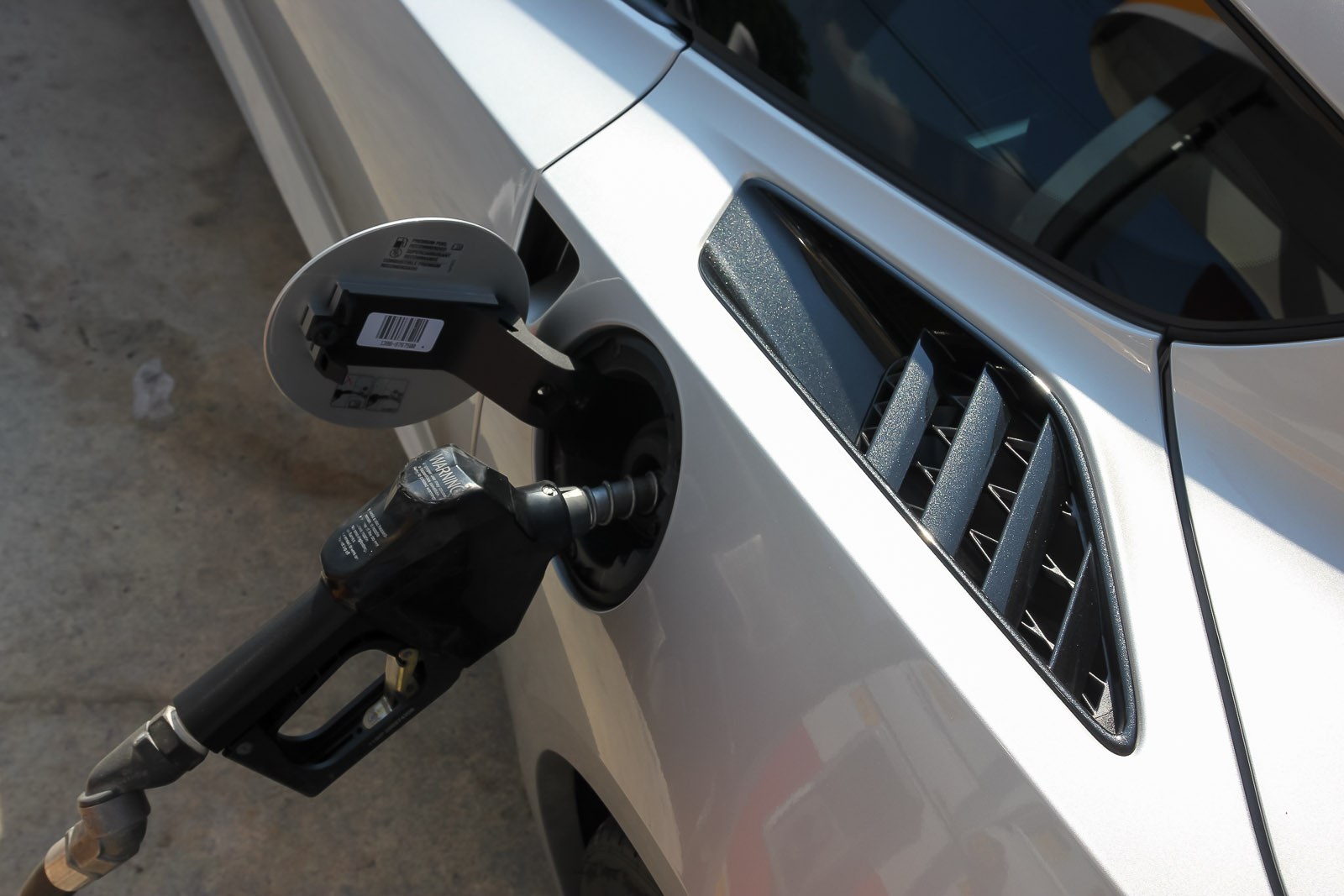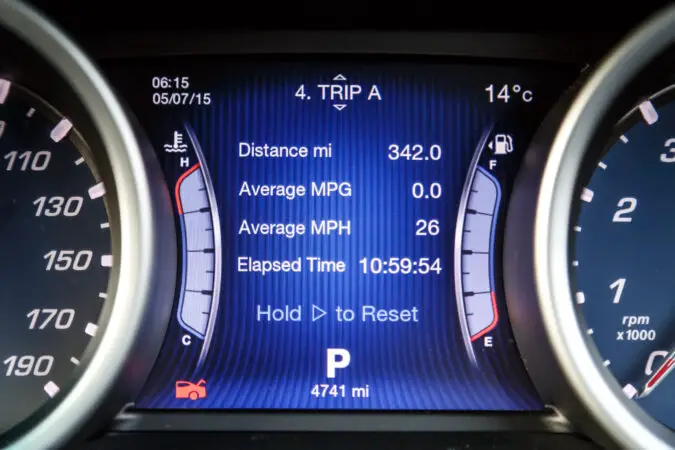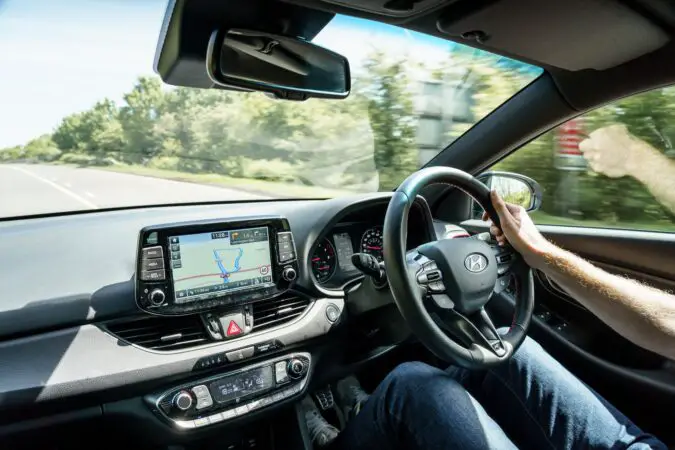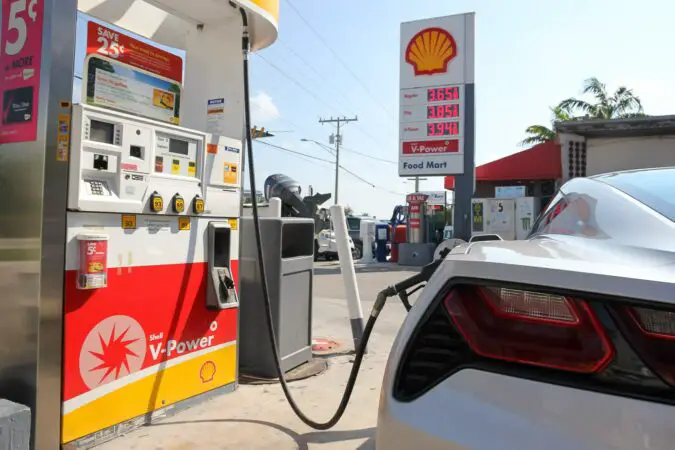As car enthusiasts, we get all sorts of car-related questions from our friends, family, and even strangers online. One of the most common questions is “how long does a full tank of gas last?” which isn’t a surprise since gas is pretty integral to car operation.
Before we proceed, we need to clarify something first. The question “how long does a full tank of gas last?” can be interpreted in two ways. First, you might mean how many miles you can travel with a full tank of gas. Second, you might mean how long it will last before it goes bad.
With that said, we’ll answer both questions. And this post will answer everything about how long a full tank of gas lasts. Here’s a table of contents to help you find the information you need:
How Long Does A Full Tank Of Gas Last: Your Mileage Will Vary
Yes, gas can go bad. But we’ll talk about that later, let’s answer the simpler question first: how many miles can you get with a full tank of gas? Well, your mileage will vary.
Cars consume gas at a different rate depending on their engine and weight. Large heavy trucks with a large engine will always consume more gas than a small lightweight hatchback. Sometimes even cars in the same segment will have a big difference in fuel consumption due to engine technology.
Of course, the size of the gas tank also affects how long it will last. If two cars consume fuel at the same rate, the car with the larger gas tank can go longer without refueling.
According to EPA research in 2020, the average fuel consumption for light-duty vehicles is around 25.7 miles per gallon. This includes anything from hatchbacks, crossovers, and light-duty trucks. Meanwhile, the average gasoline tank size in cars is between 13 to 16 gallons.
So, if your car was doing 25mpg and has a gas tank of 15 gallons, then it will last you for about 375 gallons before you need to refuel. Of course, you shouldn’t wait until it’s empty to refuel. It’s especially troublesome in diesel engines since you’ll need to bleed the system.
On average, we’d say that most cars will do between 250 to 400 miles on a full tank of gas. How long it will last will depend on how much you travel in your car each day. Some people travel no more than 20 miles, others have 50 plus miles of commutes each day.
How Long Does A Full Tank Of Gas Last: Counting Your Mileage
To count the mileage you will get in your car, you’ll need to know how large the fuel tank is in your car and your average miles per gallon. You can find the fuel tank size in your owner’s manual, or with a quick search on Google.
Simply search your car’s make, model, and year, and add “gas tank size” in the search query, and you’ll get the information you need. The trims usually don’t matter, as the gas tank usually remains the same size regardless of trim level.
As for your average MPG, most cars now come with a fuel consumption indicator and you can use that to calculate it. If your car has a 16-gallon fuel tank, and it does 20mpg, then it will last for about 320 miles. And if you drive your car for 20 miles each day, that means it will last you for about 16 days.
If your car doesn’t have an MPG indicator, then you’ll need to calculate it manually. What you need to do is fill the tank until it’s full, then restart the trip computer and drive as you would normally.
At your next fill-up, fill the tank back to full and take note of how many gallons it took until it’s full. Afterward, divide the mileage on the trip computer by the number of gallons it took to fill up the tank. The number you get is your miles per gallon consumption.
For example, if it took 10 gallons to fill the car, and you did 250 miles in-between refueling, then your car is doing 25mpg. Multiply that with the size of your gas tank, and you have the mileage range of your car.
How Long Does A Full Tank Of Gas Last: How To Increase Your Mileage
In addition to fuel consumption and tank size, your driving habits will also greatly affect how much gas your car is using. If anything, it makes the biggest impact on your car’s consumption. Here’s what you can do to save fuel and make that full tank of gas last longer:
- Inflate the tires to the correct pressure. Underinflation will cause more rolling resistance, which means the car needs more power to get going and results in more fuel consumption.
- Remove unnecessary weights. Such as baby seats or work equipment if you’re not using them. But you should keep a spare wheel, tools, and a fire extinguisher in the car in case of emergencies.
- Turn off the air-conditioning if possible. Air-conditioning saps power from the engine and can reduce MPG by as much as 25% in some cars.
- Anticipate traffic, such as not accelerating when a car in front of you is braking even if it’s far away. This way, you won’t have to accelerate as hard when the car in front of you gets going again since you won’t lose too much momentum as you approach it. And resulting in less gas consumption.
- Use cruise control only on long stretches of roads, and turn it off on hills and curvy roads. This gives you greater control over the car’s power and fuel consumption. Cruise control systems only care about maintaining speed, not gas consumption.
I find that anticipating traffic and defensive driving have the biggest effect on saving gas (especially with how to save gas). Keeping your distance and relying on your car’s momentum results in fewer stop-and-go driving situations. And in my experience, this can improve consumption by almost 5mpg.
How Long Does A Full Tank Of Gas Last: When Will It Go Bad?
Now on to the second question. As mentioned, gas can go bad. A lot of people aren’t aware of this since we use our cars almost every day and have to refuel regularly. I didn’t know this until a few years ago when my mechanic told me that the gas in my project car—which has been sitting for over three months—has gone bad.
Gas can generally last for over a year if sealed properly. However, the countdown already begins once gas leaves the pump and enters your car. It goes bad largely due to oxidation and moisture. Since ethanol—a common chemical compound in gas—can bond with water, it can suck in moisture from the outside air.
Additionally, the carbon-hydrogen compounds can evaporate when you store gas for too long. This results in the gas forming a gummy-like substance. And it can clog up the fuel system. Also, it will make gas less combustible, which can disrupt engine operation.
On average, gas will last between three to six months in a car. Note that ethanol gas is likely to be on the shorter end of the spectrum. So, don’t expect it to last more than three months.
Also, it can vary due to several things. Such as outside temperature and oxygen level. And gas in cars sitting outside in the sun might go bad earlier. Some people have even reported their gas going bad after just six weeks.
Bad Gas Symptoms Car
If you’ve been letting your car sit for a long period, now you might be worried that you have bad gasoline in the tank. Here are some signs to look out for:
Bad Gas Smell
Changes in chemical compounds usually affect the way something smells, and that includes gas. So, if your car has been sitting for months, open the gas cap and take a good whiff.
We all know what gasoline smells like (especially if you’re familiar with how to get gasoline out of clothes); it strikes your nostrils but is weirdly pleasant. Bad gas, on the other hand, is said to smell more like pungent varnish. However, in my experience, it didn’t smell like anything. When the gas in my old car went bad, it was pretty much odorless.
This might vary depending on the type of gas you use. In any case, bad gasoline will have a different smell than a good one. So, if that’s what you’re smelling, might not be a good idea to start the car.
Engine Issues
If you do decide to start your car, or you started it before you smelled it, you might notice that the engine isn’t running quite as smoothly. Engine issues due to bad gas can manifest in different ways. This includes engine misfires, knock or pinging sounds, and/or stalling.
Engine misfires are when one or more cylinders aren’t combusting the fuel and air mixture at the right time. This results in an engine that sounds like it’s limping, and you’ll notice that the RPM is hesitant to climb when you accelerate.
Engine knock or pinging sounds are a little harder to describe. They can often be very subtle and leads you to believe that the engine is behaving normally. But other times, it can be a very loud knocking noise coming from the engine.
In any case, bad gasoline can cause all of the symptoms above, possibly more. This is because bad gasoline is less flammable, and your engine won’t be able to combust the fuel and air mixture correctly leading to engine problems.
Note that many other things can cause the symptoms above. This includes a faulty Mass Airflow (MAF) sensor, bad spark plugs, and faulty fuel injectors amongst other things.
Check Engine Light
A quick lesson on the check engine light: your car is full of computers that control all the different components in your car. When one of these computers detects an error, it will try to rectify the problem on its own by adjusting the appropriate settings.
If it can’t, then the computer will register an error code in the car’s On-Board Diagnostic (OBD) system. Afterward, the OBD system will turn on the check engine light to signal to the driver that something isn’t running correctly.
If the car has an OBD-2 system—which is every car since 1996—the driver then can scan the OBD port using an OBD scanner to find the trouble codes and see what’s wrong with the car. The trouble code won’t tell you exactly what’s wrong, but it will help in diagnosing it.
You should note that bad gasoline won’t directly trigger a check engine light. This is because no sensor can detect when the fuel is bad. However, it may trigger lean mixture and fuel injector trouble codes such as P0171 and P0174.
Bad gasoline might result in the Engine Control Unit (ECU) detecting a lean fuel and air mixture, which is when there’s too much oxygen in the mixture. And it can also clog the injectors, which will also cause a trouble code.
Whatever the cause, you should take check engine lights seriously. Especially if it’s flashing, as it indicates a major issue that can seriously damage the engine. Learn more in our guide to OBD scanners.
What To Do When You Have Bad Gas In The Car
Running your engine with bad gas isn’t a good idea. It might even cause expensive damage. So, ideally, you should remove the bad gas and replace it with new gas in the tank. Here’s how to do that:
- Get hold of a container, a hose, and a fluid extractor pump.
- Open the fuel filler cap.
- Insert the hose into the fuel tank until you fill it bottom out.
- Connect the pump to the hose, and put the other end of the pump into the container.
- Pump the fluid extractor until gas comes out. Once it comes out, you don’t need to pump it anymore. Have a couple of containers on hand just in case it’s not enough.
- Keep the pump below the fuel tank to keep it flowing.
- Drain it until nothing comes out. You won’t be able to get it all out, but as long as you drain most of it out, you’ll be fine.
- Dispose of the old gas safely. It’s hazardous waste and you shouldn’t pour it down the drain. Contact your city’s waste or fire department for more information.
After draining the old gas, you’ll need to buy new gas. And you’ll need a jerrycan to transport the gas from the gas station back to wherever your car is. Most gas stations will have them on sale, or you can leave a deposit and borrow it. Don’t forget to use a funnel when refilling from a jerrycan.
A couple of jerrycans of gas should be enough to get your car from wherever it is to the nearest gas station. You can refill it to full afterward. But if you’re planning to go on a long trip or not driving the car for a long time, then you probably don’t need to do that.
Fuel Additive For Old Gas
Some people suggest that you can put additives in old gas and you’re good to go. There’s no definitive answer on whether it will work or not. But one thing is for sure: you cannot restore old gas, no matter what additives you put in it.
Additives are mainly for cleaning carbon deposits in your engine and cleaning the fuel system. This helps to restore performance and fuel efficiency, and reduce emissions. But fuel additives don’t claim they restore old gas.
While some people swear by it, we generally don’t recommend adding additives to old gas. It’s best to drain the tank and replace it with new gas to prevent any sort of damage to the engine and fuel system. Fuel additives have real benefits though, and you can learn more here.
How far can your car go on a full tank of gas? – Facts
- The average distance that a car can travel on a full tank of gas is between 200 to 400 miles.
- The factors that determine the distance your car can travel on a full tank of gas include the miles per gallon of your car, gas tank volume, and highway versus city driving.
- The MPG of your car refers to the number of miles per gallon your car gets when driving on certain road types.
- The gas tank volume is the amount of gas that your car can hold, which you can find in your owner’s manual.
- You can use the formula (MPG x gas tank capacity) to calculate the average distance that your car can travel on a full tank of gas.
- Traffic, road conditions, temperatures, tire conditions, gas tank size, oil age, fuel injectors, and air filters can all affect your car’s fuel consumption and thus its travel distance.
- Traffic congestion is a major variable that can decrease the number of miles you get out of a full tank of gas, especially in the city.
- The condition of your tires influences how much fuel you end up using, with fresh tires being vital to getting the most fuel efficiency out of your car.
- Oil, fuel injectors, and air filters all play important roles in your car’s fuel efficiency and can impact how far your car travels on a full tank of gas.
- Knowing the factors that can impede your car’s fuel efficiency and avoiding them can help ensure your car travels as far as it can on a single tank of gas, saving you some money in the process.
FAQ About How Long Does A Full Tank Of Gas Last
Again, we car enthusiasts get a lot of car-related questions. If you have any more regarding gas, here are some answers you might find helpful:
How Long Does Gas Last
Gas typically lasts anywhere between three to six months. If you’re lucky, it may last up to a year. However, ethanol gas usually lasts a little shorter and will go bad after about three months.
Does Premium Gas Last Longer
No, premium gas doesn’t have anything in it that can make it last longer. The benefit of premium gas is that it has a higher octane level. And this prevents engine knock, especially in turbocharged and high-performance engines.
What Kind Of Gas My Car Take
Take a look at the owner’s manual and you should find it there. Some cars also have a sticker near the fuel filler cap that tells you what fuel you should be using. Most older cars will take regular unleaded gasoline just fine. But newer ones will usually require mid-grade or 90-octane fuel and higher. Sports cars and luxury cars should always use premium for optimum performance and longevity.
Can You Pump Gas With The Car On
You can’t because it’s illegal. The safety risk is minimal, and I’ve done that once when I didn’t notice the engine was still on. So, the risk is minimal. But best not to play with gasoline and turn off your engine before refueling.
How Long Does Gas Last In A Can
The same as it would in a car, which is around three to six months. Ethanol gas usually lasts no more than three months. If you want to store gas for longer, you have a better chance with non-ethanol gasoline.
Is Unleaded Gas Regular Gas
Yes, they’re the same thing. The reason why we have the term unleaded gas is that they used to mix gas with tetraethyl lead to prevent engine knock. We then found out that gas was toxic to human health, and so in the ’70s, they started making unleaded gas. And it’s been the only type of gas since 1996.
What Happens When You Run Out Of Gas
Your engine will sputter, and you’ll experience intermittent power surgery. Engine backfires are also likely to happen before the engine finally dies. This may damage the fuel injector and pump due to debris from the bottom of the gas tank. In diesel cars, it’s even worse because you’ll need to bleed the entire system from the air before it can start again. Generally, a good idea to refuel before the low fuel indicator lights up.
Can You Mix Old Gas With New Gas
You can’t. If you have old stale gas in your car, you should bleed it out of the tank first before introducing new gas into it. While you probably won’t be able to bleed it all out without taking the tank out, you can bleed most of it out by using a fluid extractor pump. Once you’ve done that, you can refill it with new gas and the car will run safely.
How Long Does A Full Tank Of Gas Last: Final Thoughts
So, how long does a full tank of gas last? If you’re talking about mileage, it will last anywhere between 250 to 400 miles in most cars. Of course, it heavily depends on your car’s gas tank size, gas consumption, and driving style.
Buying a new hybrid that can do 50mpg will help save you money in the long run. But that’s not an option for everyone. So, follow our fuel-saving tips to get more out of your gas tank. Certainly helpful with current gas prices.
If you’re talking about the life of the gas itself, then it’s usually between three to six months. It may last for up to a year if you’re lucky. However, ethanol gas oxidates more easily and has a shorter shelf life. Don’t expect it to last more than three months.
There isn’t anything you can do to increase the lifespan of gas. Some additives may claim to increase it, but there’s no real proof that it does. Our advice is to not fill the tank any more than you need it to if you’re planning on not using the car for a long time.
If it does go bad, bleed the tank before you refill it with new gas. The engine won’t run smoothly with bad gas, it may not even start. Even if it starts, it can cause serious engine damage. Hopefully, this post has been helpful for you.




